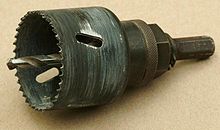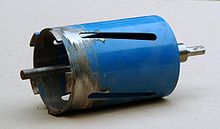
Back Serra corona Catalan Hulsav Danish Lochsäge German Sierra corona Spanish Reikäsaha Finnish Scie-cloche French Krunska pila Croatian Sega a tazza Italian Gatenzaag Dutch Hullsag NB



A hole saw (also styled holesaw), also known as a hole cutter,[1] is a saw blade of annular (ring) shape, whose annular kerf creates a hole in the workpiece without having to cut up the core material. It is used in a drill. Hole saws typically have a pilot drill bit (arbor) at their center to keep the saw teeth from walking. The fact that a hole saw creates the hole without needing to cut up the core often makes it preferable to twist drills or spade drills for relatively large holes (especially those larger than 25 millimetres (1.0 inch). The same hole can be made faster and using less power.[2]
The depth to which a hole saw can cut is limited by the depth of its cup-like shape. Most hole saws have a fairly short aspect ratio of diameter to depth, and they are used to cut through relatively thin workpieces. However, longer aspect ratios are available for applications that warrant them. Common hole saw depths are 38, 45 and 60 mm and for drilling through e.g. (angled-) rooftop constructions also a depth 165 and 300 mm[3] is possible.
Cutting with a hole saw is analogous to some machining operations, called trepanning in the trade, that swing a cutter analogous to a fly cutter in order to achieve a similar result of annular kerf and intact core.
- ^ Degarmo, E. Paul; Black, J T.; Kohser, Ronald A. (2003), Materials and Processes in Manufacturing (9th ed.), Wiley, p. 593, ISBN 0-471-65653-4.
- ^ "The 7 Best Hole Saws in 2023 - Best Hole Saw Kit". Popular Mechanics. 2023-05-04. Retrieved 2023-06-13.
- ^ "Long hole saws used for deep and thickwall constructions". Mandrex - Extra deep and long hole saws. 2023-08-15.